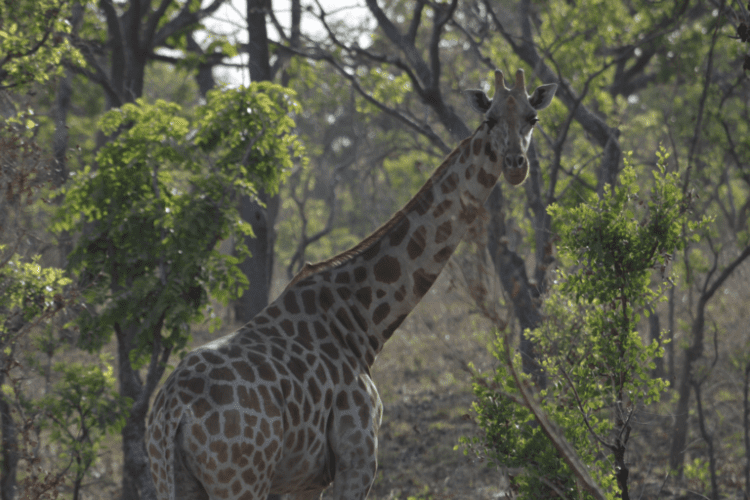According to a recent study, losing two Kordofan giraffes each year would lead to local extinction of the subspecies within Cameroon’s Bénoué National Park in just 15 years.The study found that antipoaching measures are the most effective way to prevent extinction, including robust patrols by guards, strengthening law enforcement, and providing sustainable livelihoods to people living around the park.Kordofan giraffes are a critically endangered subspecies with an estimated 2,300 individuals remaining, of which fewer than 300 are found in Bénoué National Park.The authors also stress the importance of identifying, restoring and protecting wilderness corridors to connect populations of giraffes across the region.
If just two Kordofan giraffes are killed each year, the subspecies could be locally extinct in just 15 years within Cameroon’s Bénoué National Park. This is according to a new study by the University of Bristol and the Bristol Zoological Society, published in the African Journal of Ecology.
“We expected poaching to be driving population decline within the park. However, we did not expect that extinction could be reached within such a short time scale,” study co-author Samuel Penny, a lecturer at the Bristol Zoological Society’s Institute of Conservation Science and Learning, told Mongabay in an email. “This is worrying.”
Kordofan giraffes (Giraffa camelopardalis antiquorum) are a critically endangered subspecies of giraffes found across Cameroon, the Central African Republic, Chad, the Democratic Republic of Congo and South Sudan. The overall population stands at around 2,300 individuals, of which there are estimated to be fewer than 300 individuals in Bénoué National Park.
A Kordofan giraffe in Cameroon’s Bénoué National Park. Only an estimated 300 individuals remain in the park, threatened by poaching and habitat loss. Image courtesy of Bristol Zoological Society.
Giraffes are hunted illegally for their meat, bones, hair and tails. Their skins are also used in some luxury goods and as rugs. These large mammals are an easy kill compared to other ungulates, meaning poachers get a big bang for their buck and a lot of meat.
“Recent confirmed reports of the poaching of two giraffes in a period of just three months highlight the urgency of conservation intervention,” study lead author Kane Colston, who undertook the research as part of his master’s degree, said in a statement.
Political instability around Cameroon have made the Kordofan giraffes there more likely to be hurt by things like poaching, illegal pastoralism and mining encroachment.
The study evaluated different ways to protect the giraffe population using population viability analyses. The researchers examined how well strategies like antipoaching measures, adding more giraffes to the population, and habitat restoration would work. They tested these strategies separately and in combination to see how they would affect the giraffe population and extinction probability over the next 100 years.
They found that removing one male and one female every five years would cause a 98.1% probability of extinction in 100 years. Removing two a year would cause an extinction in just 15 years.
The study found that antipoaching measures are the most effective way to prevent this extinction. These include robust patrols by guards, strengthened law enforcement, and more community engagement.
Political instability around Cameroon have made the Kordofan giraffes there more likely to be hurt by things like poaching, illegal pastoralism and mining encroachment.
“Climate change-induced desertification and terrorism-related displacement have led to an influx of refugees across the region,” Penny said. “Law enforcement measures alone cannot reduce resource extraction in the park. Instead, these should occur in tandem with conservation initiatives that work to provide sustainable livelihoods to those living around the park.”
Kordofan giraffes are the shortest of the subspecies, ranging from 3.8-4.7 meters (12.5-15.4 feet) in height. They feed on leaves, grasses, buds, shoots and seeds, and communicate through low-frequency infrasonic range, often inaudible to humans, except for a mother’s call to her young.
The poaching of females significantly affects population viability more than the poaching of males. Female giraffes can start getting pregnant when they are about 4 years old and carry their young for around 15 months (a much longer gestation period than the nine months for humans). Male giraffes, by contrast, reach sexual maturity much later.
The study found that bringing more female giraffes into the park would help the population. However, the authors don’t recommend translocating giraffes from one place to another. They note that it’s difficult and expensive to move a giraffe, and that until threats such as illegal hunting are dealt with, the new giraffes face the same risks as the local ones.
Instead, the study suggests protecting pathways between habitats, known as corridors. These corridors can help giraffe populations grow by allowing them to move between different areas naturally, benefiting genetic diversity.
“Fewer than 2,300 Kordofan giraffes remain across central Africa,” Penny said, “underscoring the need to protect the remaining and often isolated populations from reaching extinction.”
Banner image: A Kordofan giraffe caught on camera by a camera trap. Image courtesy of the Bristol Zoological Society. A Kordofan giraffe in Cameroon’s Bénoué National Park. Image courtesy of Bristol Zoological Society.
Citation:
Colston, K. P., Johnson, C. L., Nyugha, D., Mengamenya Goué, A., & Penny, S. G. Viability analysis of Kordofan giraffe (Giraffa camelopardalis antiquorum) in a protected area in Cameroon. African Journal of Ecology. doi:10.1111/aje.13196
Poachers kill two rare white giraffes
FEEDBACK: Use this form to send a message to the author of this post. If you want to post a public comment, you can do that at the bottom of the page.
Animals, Anti-poaching, Biodiversity, Climate Change, Conservation, Endangered Species, Environment, Forests, Giraffes, Green, Hunting, Mammals, Over-hunting, Poachers, Poaching, Protected Areas, Research, West Africa, Wildlife, Wildlife Conservation
Africa, Cameroon, West Africa
Source link : https://news.mongabay.com/2023/08/kordofan-giraffes-face-local-extinction-in-15-years-if-poaching-continues/
Author :
Publish date : 2023-08-16 07:00:00
Copyright for syndicated content belongs to the linked Source.
